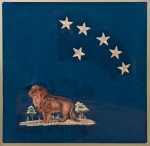UNIFORM GUIDELINES PAGE 5
29. Overcoat: Foot Pattern only, unless scenario specifically permits. Some features include a greenish cast sky blue kersey wool with a diagonal weave, standing three inch collar, two sets of hooks and eyes, hand sewn button holes and buttons using dark blue or logwood faded (brown) cotton or linen thread, body lining of dark blue kersey wool or a light brown wool & cotton/linen mixed lining, sleeve lining of cotton muslin, cape with six 5/8 inch general service eagle buttons, front with five 3/4-inch general service eagle buttons, back half belt with two 3/4-inch service eagle buttons attached, two piece cuffs, and a un-hemmed skirt bottom.
30. Rifle-Musket Sling: Leather rifle-musket slings should be of documented patterns only. The US regulation sling was a leather strap, 46 inches long and 1 1/4 inch wide, with a captive loop at one end, and a brass hook at the other, and a sliding keeper between. The leather specified was "russet bag-leather," which was a brown color, lighter weight leather. It should be free of rivets, except those holding the hook on. The captive loop and the sliding keeper were sewn, not riveted. The hook should be a flat brass hook with a point, about 3/4-inch long. It should not be made of brass or iron wire. The end of the sling should be folded over & sewn, and the back of the hook should pass between these leather pieces, and be riveted with two small brass rivets.
These items should generally be carried in a soldier's pockets or knapsack. Some items are only appropriate for a camp impression. These should be rather limited in your kit.
Housewife: The sewing kit of the common soldier used during the Civil War. Generally homemade of cotton (shirting material), linen, wool, or silk, entirely hand sewn using cotton or linen thread; with compartments for thread, buttons, needles, and patching material. They should neatly roll up or fold, and be secured by two cloth ties or a hand sewn button. Leather housewives or those of a black tarred exterior coating are also acceptable, but must be patterned after a documented wartime article. These may be either hand or machine sewn, with compartments for thread, buttons, needles, and patching material.
Matches: Generally made out of pine, with red tips, and contained in period cardboard matchbox. Make sure label is of a documented manufacturer, and not a modern maker. Matches were issued to soldiers as well in attached strings or single sticks.
Match Box: A private purchase item that some soldiers used to protect their matches from getting damp and wet. Francis A. Lord, in his Civil War Collector's Encyclopedia, states,' "One of the author's collection is of heavy tin, oval in shape, 3-¼ inches long, 2-¼ inches wide" (162). Look at antique stores for some plain tin matchboxes. Avoid most sutler-row matchboxes, which contain modern markings and designs.
Cotton Napkin: Another item from home or purchased privately. Made out of cotton (the same fabric as your civilian shirt), with two to three colored woven patterns such as small plaids, checks, & stripes. The woven patterns should be the same on the reverse side of the fabric. A simple ¼ inch overlapped hand sewn (whip stitched) border is an additional touch that will prevent fraying of the material. Approximate size should be around 24 x 24 inches. Period cotton towels of correct pattern and weave are also appropriate such as huck toweling.
Pocket Watch: Key wind watches with relatively plain silver, silver alloy, or highly expensive gold watch covers and backings. Look for roman numerals. You can expect to pay quite a bit for an accurate Civil War timepiece. These will be closely inspected for accuracy. Watch chains are acceptable, as well as just used a piece of leather (shoelace), tied to their suspenders.
Pipes: Stick with simple pipes that an enlisted man of limited means would carry. These were commonly made of briar, clay, or wood with corresponding reed or wood stems. The use of Period tobacco is highly encouraged. Plain rolled cigars are also allowed, but absolutely no modern cigarettes. There is a zero tolerance policy in the 24th Missouri for smoking modern cigarettes in any area where we are live in impression.
Toothbrush: Comprised of wood or bone handles with either horsehair or boars' hair bristles commonly called "natural bristles." Please remove any modern markings. Tooth powder or baking soda shall only be used with your toothbrush.
Wallet: A private purchase item that some soldiers used to organize any small bills that they had. All wallets shall be correct in pattern, materials, and construction per original specimens. Materials such as leather and rubber were common per original wallets along with hand sewn or machine sewn compartments. Francis A. Lord, in his Civil War Collector's Encyclopedia, states, "Most wallets were of brown leather, 4 to 4-½ inches long and 2-½ to 3 inches wide. Many have a wrap-around strap.
Mirror: A small tin or wooden cased looking glass, should be of approximately three inches in diameter. No modern markings allowed.
Comb: Composed of wood, bone, or hard rubber. Hard rubber folding combs are easier to carry than straight wooden or bone combs. Once again, no modern markings allowed.
Pens, Ink, & Pencils: Pens should be rather plain with steel or wooden points, with straight, unpainted wooden shafts with metal fixtures on the business ends to accept nibs. Ink should be black in color, and carried in a tin, glass, or wooden inkwell. Pencils should be plain, without modern markings and erasers.


